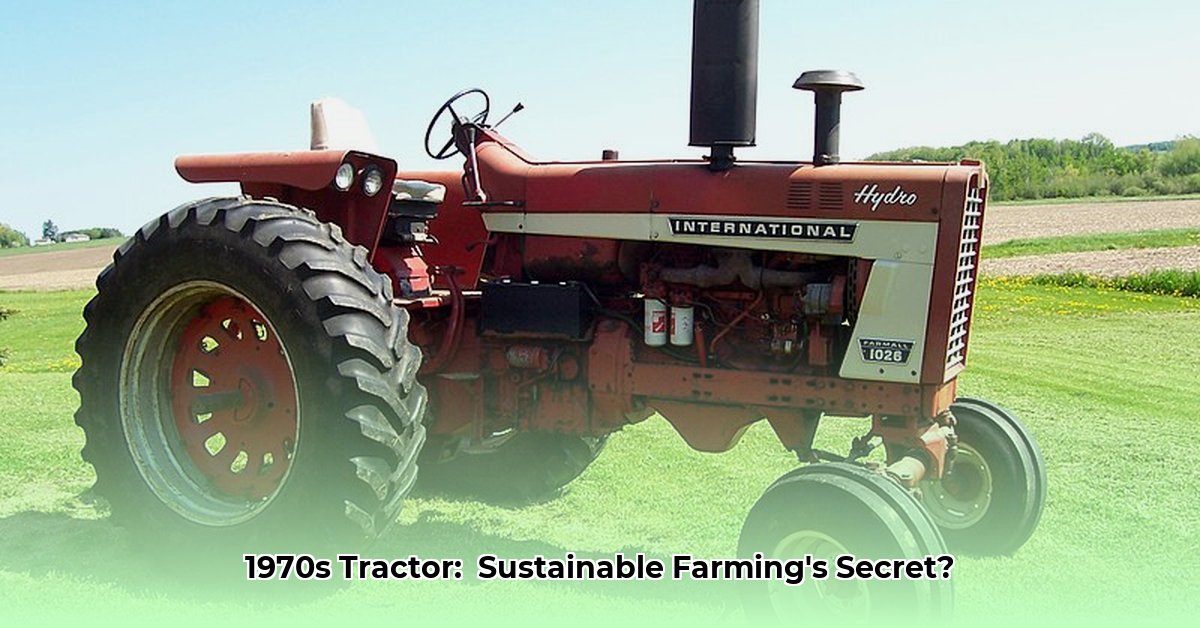
A Legacy Forged in Steel and Soil
Imagine the dawn breaking over a vast field in 1970. The air is crisp, dew clinging to the emerald stalks of wheat. The rhythmic chug of a 1970 International Harvester tractor – a deep, resonant hum – punctuates the quiet. This wasn't just a machine; it was a symbol of a changing agricultural landscape, a transition that brought both remarkable progress and unforeseen challenges. This article explores the 1970 International tractor's impact on farming, examining its contributions to both increased efficiency and the complex legacy of its environmental effects. We will consider its design innovations, its impact on farming practices, and the ongoing conversation surrounding sustainability in agriculture. For more images and details, see this dedicated website.
The Machine and its Moment in Time
The 1970s witnessed a burgeoning agricultural revolution. Farmers, striving for larger harvests, turned to increasingly powerful machinery. The International Harvester tractor, a robust workhorse, answered that call. Its design incorporated several key innovations. More powerful engines allowed farmers to cultivate larger areas more quickly. Improved hydraulic systems simplified attaching and operating implements, boosting efficiency. The result? Farmers could plant and harvest more, significantly increasing yields. This increase in productivity profoundly impacted agricultural practices.
Uncle Jed, a farmer from Iowa, fondly recalled his 1970 International, nicknamed "Old Bess." He would often recount how "Old Bess" dramatically reduced his workload, enabling him to manage significantly more acreage without extra help. This was a common experience; the tractor was a true game-changer for countless farmers.
Revolutionizing Farming Practices: A Double-Edged Sword
The 1970 International tractor didn't just increase output; it fundamentally altered the scale of farming. Larger farms became the norm, leading to increased efficiency. However, this progress had unforeseen consequences. Let's examine both the positive and negative impacts:
| Aspect | Positive Impacts | Negative Impacts |
|---|---|---|
| Productivity | Higher yields, faster planting and harvesting times | Shift towards large-scale farming, potentially monoculture practices |
| Efficiency | Less manual labor, time savings | Increased fuel consumption, reliance on fossil fuels |
| Environmental Impact | Initially, limited environmental considerations | Soil compaction, habitat loss, increased greenhouse gas emissions |
Did this increased productivity outweigh the environmental costs? That's a question that continues to be debated today.
Sustainability: A Critical Examination
The increased efficiency associated with larger farms and powerful machinery came at a cost. More fuel, fertilizers, and pesticides were needed, increasing reliance on fossil fuels and raising significant environmental concerns. Soil compaction, a direct consequence of heavier machinery, degraded long-term soil health. Some experts argue that this period represented a pivotal shift away from sustainable farming practices. However, it's crucial to remember that the tractor itself wasn't solely to blame. Individual farming practices also played a vital role. Some farmers, even with powerful machinery, employed sustainable techniques, proving that technology and environmental responsibility aren't mutually exclusive.
A Legacy that Endures: Lessons for the Future
The 1970 International tractor's legacy extends beyond its initial impact. Its design and influence continue to shape modern agricultural equipment produced by Case IH, the company that inherited International Harvester's legacy. However, the focus has shifted. Sustainability is no longer optional; it's imperative. Modern tractors incorporate advanced technologies like GPS and precision sensors, allowing for targeted resource use and minimizing environmental impact. The 1970 International serves as a powerful reminder that progress is an ongoing process of learning, adaptation, and innovation. The future of farming necessitates a delicate balance between efficiency and environmental responsibility.
How Did International Harvester Tractors Impact Sustainable Farming Practices?
The 1970s marked a turning point in agriculture. International Harvester (IH) tractors were pivotal, but their impact on sustainability remains a subject of ongoing discussion.
Technological Advancements and their Impact
The 1970 IH tractor represented a leap forward in agricultural technology. Improvements in engine power and fuel efficiency (relative to earlier models), and the introduction of features like the Power Take-Off (PTO) system, significantly boosted efficiency. But were these advancements universally beneficial for sustainable farming?
Impact on Farming Practices: A nuanced perspective
IH tractors dramatically changed farming, enabling the cultivation of larger fields and resulting in greater yields. Mechanization reduced labor needs. However, this efficiency often came at a cost. The increased scale frequently led to monoculture farming, potentially harming soil health and biodiversity.
A Deeper Dive into Sustainability
Let's analyze the sustainability impact of IH tractors objectively:
Pros:
- Improved Efficiency: Increased power and PTO system boosted productivity and reduced labor requirements.
- Increased Yield: Larger fields led to higher crop yields, improving food production.
Cons:
- Increased Fuel Consumption: While comparatively more fuel-efficient than predecessors, overall fuel consumption was significantly higher than current standards, leading to a considerable carbon footprint.
- Soil Degradation: Large-scale farming, often associated with IH tractor use, contributed to soil nutrient depletion.
- Environmental Impact: The manufacturing and disposal of these tractors added to environmental burdens.
A Legacy of Innovation and Challenges
The legacy of IH tractors is complex. They brought efficiency, but also contributed to the sustainability challenges we face today. The challenge remains: how can we learn from this history to create more sustainable agricultural practices? The future lies in balancing productivity with environmental protection.
Key Takeaways:
- IH tractors dramatically increased agricultural efficiency and productivity.
- Mechanization facilitated larger-scale farming, boosting yields.
- However, this came at the cost of increased fuel consumption, soil degradation, and broader environmental impact.
- The IH legacy underscores the ongoing need to balance efficiency and sustainability in modern agriculture.